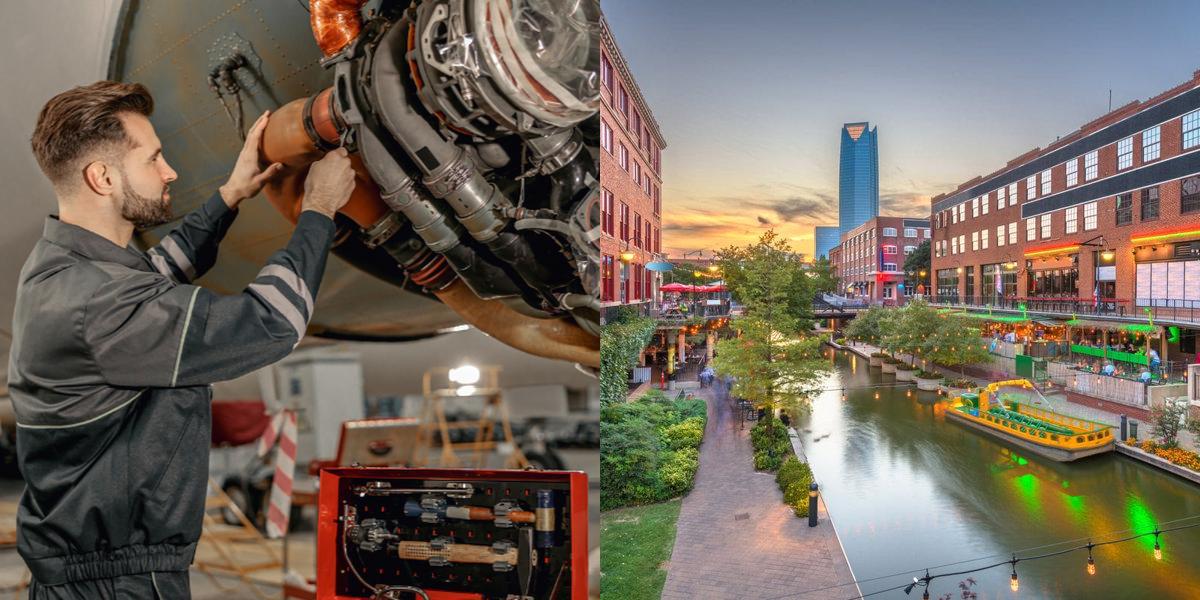How to Become an Aviation Mechanic in Oklahoma

What is an Aviation Mechanic?
Aviation mechanics, also known as aircraft mechanics or aircraft maintenance technicians, are responsible for inspecting, repairing, and maintaining aircraft to ensure they are safe and in optimal working condition. They work on various types of aircraft, including airplanes and helicopters, and their responsibilities include performing routine inspections, diagnosing mechanical or electrical issues, repairing or replacing faulty components, and conducting necessary tests to ensure the aircraft is airworthy.
How do I get a job as an Aviation Mechanic?
After obtaining your aviation mechanic certification, you may be wondering how to go about finding a job in the field. Here are some steps you can take to increase your chances of getting hired as an aviation mechanic:
-
Create an Impressive Resume: Start by creating a well-written resume that highlights your education, practical experience, and any relevant skills or certifications you have obtained. Be sure to tailor your resume to the specific job you are applying for and include any relevant coursework or projects you completed during your training.
-
Network: Networking is an essential part of finding a job in any industry, and aviation is no exception. Attend industry events, join professional organizations, and connect with other aviation professionals on platforms like LinkedIn. Building a strong network can help you uncover job opportunities and get referrals from people within the industry.
-
Search for Job Openings: Look for job openings at aviation maintenance facilities, airlines, and other aviation-related companies. Check online job boards, company websites, and industry-specific websites for available positions. Be proactive in your search and regularly check for new job postings.
-
Apply for Jobs: Once you find job openings that match your qualifications, submit your resume and cover letter. Tailor your application to each specific job by highlighting relevant skills and experience. Be sure to follow the application instructions provided by the employer and submit your application before the deadline.
-
Prepare for Interviews: If your application is selected, you may be invited for an interview. Prepare for the interview by researching the company, reviewing common interview questions, and practicing your answers. Be prepared to discuss your education, practical experience, and any relevant projects you have worked on.
-
Demonstrate Your Skills: During the interview process, be prepared to demonstrate your skills and knowledge of aircraft maintenance. Employers may ask technical questions or give you scenarios to assess your problem-solving abilities. Be confident and showcase your expertise to make a strong impression.
-
Consider Apprenticeships or Entry-Level Positions: If you are having difficulty finding a job as a certified aviation mechanic, consider starting with an apprenticeship or entry-level position. These opportunities can provide valuable hands-on experience and allow you to build a network within the industry. As you gain experience and prove your skills, you can work your way up to higher-level positions.
Career Paths and Opportunities after Becoming an Aviation Mechanic
After becoming a certified aviation mechanic, there are several career paths and opportunities you can explore within the aviation industry. Here are some potential career paths you can consider:
-
Airlines: Many aviation mechanics find employment with commercial airlines. In this role, you would be responsible for maintaining and repairing the aircraft in the airline's fleet. You may work in a hangar or at an airport, performing routine inspections, troubleshooting issues, and ensuring the aircraft are safe and in optimal working condition.
-
General Aviation: General aviation includes all non-commercial flights, such as private, corporate, and recreational flying. In this sector, you could work at a small aviation maintenance facility, servicing private aircraft, or for a company that operates a fleet of corporate jets. The work in general aviation can be diverse and may involve maintaining different types of aircraft.
-
Military: The military has its own aviation maintenance needs, and becoming an aviation mechanic in the military can be a rewarding career choice. As a military aviation mechanic, you would be responsible for maintaining military aircraft and ensuring they are ready for combat or other missions. This career path often comes with additional benefits such as healthcare, housing, and retirement plans.
-
Helicopter Maintenance: Helicopters have unique maintenance requirements, and specializing in helicopter maintenance can open up additional career opportunities. Helicopter mechanics work on a variety of rotorcraft, including medical helicopters, law enforcement helicopters, and commercial helicopters used for transportation and tourism.
-
Manufacturers and Suppliers: Aircraft manufacturers and suppliers also employ aviation mechanics. In this role, you could work in a manufacturing facility, assembling and testing new aircraft, or in a supplier company, maintaining and repairing aircraft components. This career path can provide you with an in-depth understanding of aircraft systems and the opportunity to work on cutting-edge technology.
-
Quality Control and Inspection: If you have a keen eye for detail and a strong understanding of regulations and safety standards, a career in quality control and inspection may be a good fit for you. In this role, you would be responsible for inspecting aircraft and ensuring they meet all regulatory requirements. You may also be involved in auditing maintenance procedures and ensuring compliance with industry standards.
These are just a few examples of the career paths you can pursue after becoming an aviation mechanic. With experience and additional certifications, you can also advance into roles such as aviation maintenance manager, instructor, or consultant.
Final Thoughts
Becoming a certified aviation mechanic can open up a world of opportunities in the aviation industry. By following the steps outlined by the FAA, completing the required education and practical experience, and passing the necessary exams, you can obtain your aviation mechanic certification. Once certified, you can start your career by creating an impressive resume, networking, and applying for job openings. Consider different career paths within the industry, such as working for airlines, in general aviation, or in the military. With experience and additional certifications, you can advance your career and take on more challenging roles. The aviation industry is constantly evolving, and as an aviation mechanic, you will have the opportunity to work with cutting-edge technology and contribute to the safety and efficiency of aircraft.
If this article isn't quite hitting the mark for you, why not give these other articles a try:




